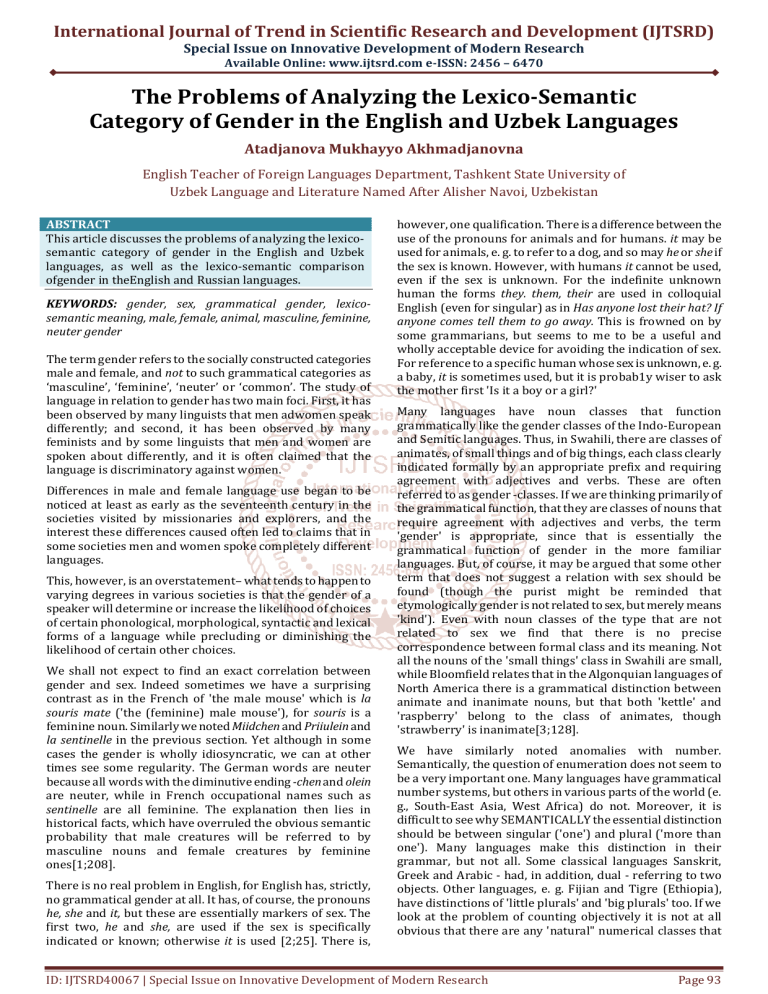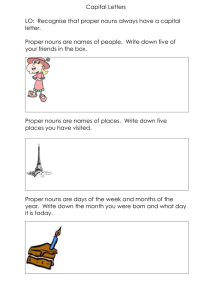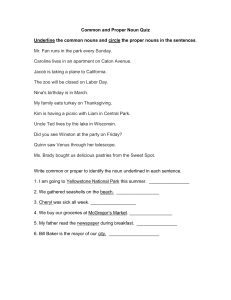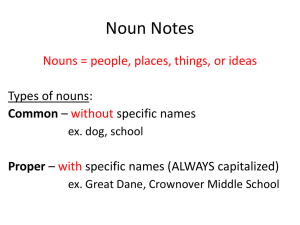
International Journal of Trend in Scientific Research and Development (IJTSRD)
Special Issue on Innovative Development of Modern Research
Available Online: www.ijtsrd.com e-ISSN: 2456 – 6470
The Problems of Analyzing the Lexico-Semantic
Category of Gender in the English and Uzbek Languages
Atadjanova Mukhayyo Akhmadjanovna
English Teacher of Foreign Languages Department, Tashkent State University of
Uzbek Language and Literature Named After Alisher Navoi, Uzbekistan
ABSTRACT
This article discusses the problems of analyzing the lexicosemantic category of gender in the English and Uzbek
languages, as well as the lexico-semantic comparison
ofgender in theEnglish and Russian languages.
KEYWORDS: gender, sex, grammatical gender, lexicosemantic meaning, male, female, animal, masculine, feminine,
neuter gender
The term gender refers to the socially constructed categories
male and female, and not to such grammatical categories as
‘masculine’, ‘feminine’, ‘neuter’ or ‘common’. The study of
language in relation to gender has two main foci. First, it has
been observed by many linguists that men adwomen speak
differently; and second, it has been observed by many
feminists and by some linguists that men and women are
spoken about differently, and it is often claimed that the
language is discriminatory against women.
Differences in male and female language use began to be
noticed at least as early as the seventeenth century in the
societies visited by missionaries and explorers, and the
interest these differences caused often led to claims that in
some societies men and women spoke completely different
languages.
This, however, is an overstatement– what tends to happen to
varying degrees in various societies is that the gender of a
speaker will determine or increase the likelihood of choices
of certain phonological, morphological, syntactic and lexical
forms of a language while precluding or diminishing the
likelihood of certain other choices.
We shall not expect to find an exact correlation between
gender and sex. Indeed sometimes we have a surprising
contrast as in the French of 'the male mouse' which is la
souris mate ('the (feminine) male mouse'), for souris is a
feminine noun. Similarly we noted Miidchen and Priiulein and
la sentinelle in the previous section. Yet although in some
cases the gender is wholly idiosyncratic, we can at other
times see some regularity. The German words are neuter
because all words with the diminutive ending -chen and olein
are neuter, while in French occupational names such as
sentinelle are all feminine. The explanation then lies in
historical facts, which have overruled the obvious semantic
probability that male creatures will be referred to by
masculine nouns and female creatures by feminine
ones[1;208].
There is no real problem in English, for English has, strictly,
no grammatical gender at all. It has, of course, the pronouns
he, she and it, but these are essentially markers of sex. The
first two, he and she, are used if the sex is specifically
indicated or known; otherwise it is used [2;25]. There is,
however, one qualification. There is a difference between the
use of the pronouns for animals and for humans. it may be
used for animals, e. g. to refer to a dog, and so may he or she if
the sex is known. However, with humans it cannot be used,
even if the sex is unknown. For the indefinite unknown
human the forms they. them, their are used in colloquial
English (even for singular) as in Has anyone lost their hat? If
anyone comes tell them to go away. This is frowned on by
some grammarians, but seems to me to be a useful and
wholly acceptable device for avoiding the indication of sex.
For reference to a specific human whose sex is unknown, e. g.
a baby, it is sometimes used, but it is probab1y wiser to ask
the mother first 'Is it a boy or a girl?'
Many languages have noun classes that function
grammatically like the gender classes of the Indo-European
and Semitic languages. Thus, in Swahili, there are classes of
animates, of small things and of big things, each class clearly
indicated formally by an appropriate prefix and requiring
agreement with adjectives and verbs. These are often
referred to as gender -classes. If we are thinking primarily of
the grammatical function, that they are classes of nouns that
require agreement with adjectives and verbs, the term
'gender' is appropriate, since that is essentially the
grammatical function of gender in the more familiar
languages. But, of course, it may be argued that some other
term that does not suggest a relation with sex should be
found (though the purist might be reminded that
etymologically gender is not related to sex, but merely means
'kind'). Even with noun classes of the type that are not
related to sex we find that there is no precise
correspondence between formal class and its meaning. Not
all the nouns of the 'small things' class in Swahili are small,
while Bloomfield relates that in the Algonquian languages of
North America there is a grammatical distinction between
animate and inanimate nouns, but that both 'kettle' and
'raspberry' belong to the class of animates, though
'strawberry' is inanimate[3;128].
We have similarly noted anomalies with number.
Semantically, the question of enumeration does not seem to
be a very important one. Many languages have grammatical
number systems, but others in various parts of the world (e.
g., South-East Asia, West Africa) do not. Moreover, it is
difficult to see why SEMANTICALLY the essential distinction
should be between singular ('one') and plural ('more than
one'). Many languages make this distinction in their
grammar, but not all. Some classical languages Sanskrit,
Greek and Arabic - had, in addition, dual - referring to two
objects. Other languages, e. g. Fijian and Tigre (Ethiopia),
have distinctions of 'little plurals' and 'big plurals' too. If we
look at the problem of counting objectively it is not at all
obvious that there are any 'natural" numerical classes that
ID: IJTSRD40067 | Special Issue on Innovative Development of Modern Research
Page 93
International Journal of Trend in Scientific Research and Development (IJTSRD) @ www.ijtsrd.com eISSN: 2456-6470
might be expected to be shown in the grammar of all or most
languages.
More important, perhaps, is the need to distinguish between
individual and mass. This is a distinction that English makes
quite clearly, though it is often ignored in the grammar
books. The category is referred to as COUNT ABILITY, with
the noun classes of COUNTABLES and UNCOUNTABLES or
COUNT and MASS. Examples of count nouns are cat and book,
while butter and petrol are mass nouns. Formally the two
classes are easily distinguished. Count nouns alone may
occur in the singular with the indefinite article a - a cat (but
not *a butter), while only mass nouns may occur with no
article or with the indefinite quantifier some (not some in the
sense of 'some or other') - Butter is ..., some butter (but not
*Cat is ..., * some cat). Some nouns, e. g. cake, fish belong to
both classes[4;137].
The semantic difference between these two classes is clear
enough. The count nouns 'individuate' - they indicate
individual specimens, while the mass nouns refer to a
quantity that is not individuated in this way. But the
distinction does not correspond closely to any semantic
distinction in the world of experience, and this should be no
cause for surprise. It is true that liquids are always referred
to by mass nouns because they cannot be individuated.
There is no obvious object that can be described as *a water.
But there is no explanation in semantic terms why butter is a
mass noun while jelly is count as well as mass; there is no
semantic reason why we can refer to a single mass of jelly as
a jelly but not to a mass of butter as *a butter. On the other
hand, while cake is count as well as mass, for the obvious
reason that individual cakes can be recognised, bread is only
mass we cannot talk of *a bread, but have to use a different
word, loaf. A foreigner could not guess, then, whether such
words as soap, trifle, cheese would be count nouns in English.
He has, moreover, to learn the 'individuating' nouns loaf of
bread, cake of soap, pat of butter.
The count mass distinction is a fairly clear one - it classifies
English nouns, though some, e. g. fish, belong to both classes.
But mass nouns can, nevertheless, function as count nouns.
Two obvious functions are, first, the use of such expressions
as a butter, a petrol to mean 'a kind of butter' or 'a kind of
petrol', and secondly a coffee, a beer to mean 'a cup of coffee'
and 'a glass of beer'. It is best to treat these nouns as
'basically' mass nouns and these functions as types of
individuation that can be applied to them for specific
purposes - to indicate kinds and, with liquids, familiar
quantities. Similarly, count nouns that refer to creatures may
function as mass nouns to indicate the meat; we find not
merely familiar usages such as chicken, rabbit, fish but can
also freely form mass nouns elephant, crocodile and even dog
(The Chinese eat dog) to refer to the meat. (But we have, of
course, the specific words befif, mutton, pork, venison for the
flesh of cattle, sheep, pigs and deer.)
Semantically, mass nouns are nearer to plurals than to
singular forms of count nouns. This accounts for the anomaly
of oats and wheat - there is little difference, unless it is
clearly specified, between a large number of grains and a
mass of them. In some languages liquids are not mass nouns,
but plurals, e. g. in Bilin the word for 'water'.
The term 'count' is relevant to the fact that most count nouns
can be counted - one book, two/three/four books. But there
are two reservations. First, English has the words scissors,
trousers, shears, tongs, etc., which are formally plural, but
cannot be enumerated except by using another noun a pair of
-; this is formally like the individuators of the mass nouns, a
cake of soap, a pat of butter. Secondly, although English uses
the plural form with numbers above one, not all languages
do. In Welsh, for instance, 'four dogs' is pedwar ci, though
'dog' is ci and 'dogs' cwn. In Tigre there are many mass nouns
which have a singulative (individuating) form made by a
suffix, e. g. nahab 'bees', but nahbat 'a bee'. But the
singulative form is the form used with all numerals - not
merely 'one' hatte nahbat 'one bee', satas nahbat 'three bees',
etc. What seems to be important here is not plurality, but
individuation.
The problems of gender as a lexico-semantic category in
Uzbek appear in comparing words in three languages:
English: mother, sister, girl, lady, woman, Helen, poetess, directress, aunt, hen, cow.
Uzbek:она, опа, қиз, аёл, хоним, Ҳалима, шоира, раққоса,
артистка, бия, хола
Russian: мать, девушка, женщина, сестра, Катя,
поэтесса, сударыня, балерина, учительница, тетя,
корова, курица.
Uzbek nouns denoting male and female sex are of no
grammatical significance in contrast to English and Russian
ones. The grammatical significance of English nouns
denoting male and female sexis observed when they are
replaced by the pronouns he and she:[5;25]
I have a brother. He is a doctor.
teacher.
I have a sister. She is a
Some of the nouns denoting living beings do not express sex:
1. human beings: doctor, friend, cousin, teacher, stranger,
neighbour, student, clerk, etc.
2. animals: wolf, dog, bear, eagle, ass, goat, elephant, etc.
If we desire to indicate the sex of what is expressed by those
nouns, a word denoting the sex is added to them: boy-friend,
girl friend; man-servant, maid-servant; man-doctor, womandoctor; male elephant, female elephant; he-dog, she-dog; male
(tom-, he-) cat, female- (pussy- she-) cat; he- (billy-) goat, she(nanny-) goat; dog- (he-) wolf, she-wolf, etc.
In Spoken English there is a tendency to associate the names
of animals with the female or male sex.
1. When the noun indicates the sex of the animal it is
generally spoken of as he (lion, tiger, bull, etc) or she
(lioness, tigress, cow, etc.);
The tiger approached the camp: his dreadful roar made us
shudder.
The bull lowered his head.
Our dog is called Jenny; she is of a very good breed.
2.
When the sex of the animal is not indicated by the noun,
nouns denoting the larger and bolder animals are
generally associated with the male sex (elephant, horse,
dog, eagle, etc), while nouns denoting the smaller and
weaker ones with the female (cat, hare, parrot, etc):
The elephant lifted his mighty trunk.
The cat has upset her milk.
In English inanimate things or abstract notions are usually
personified and the nouns denoting them are referred to as
ID: IJTSRD40067 | Special Issue on Innovative Development of Modern Research
Page 94
International Journal of Trend in Scientific Research and Development (IJTSRD) @ www.ijtsrd.com eISSN: 2456-6470
belonging to those of the male or female sex. Here are some
traditional associations:
1. The things and notions expressed by the noun sun and
by the nouns expressing such ideas as strength,
fierceness(anger, death, fear, war, etc) are associated
with the male sex:
English nouns denoting sex cause more interferences when
English is spoken by Uzbeks, than by Russians. Uzbek
students usually make mistakes when replacing them with
the pronouns he or she. It. is difficult for Uzbeks and
Russians to express sex in English when the means of
expressing it differ.
It is pleasant to watch the sun in his chariot of gold, and the
moon in her chariot of pearl. (Wilde)
RENDERING OF THE ENGLISH NOUNS DENOTING SEX IN
UZBEK
... it seamed as if death were raging round this floating prison
seeking for his prey. (Irving.)
2.
The things and notions expressed by the nouns moon
and earth, by the names of vessels (ship, boat, steamer,
etc), vehicles (car, carriage, coach, etc), countries and by
the nouns expressing such ideas as gentleness, beauty
(kindness, spring, peace, dawn, etc) are associated with
the female sex:
The Moon was behind the clouds but an hour later we saw her
in full.
She is a good car.
She was a good boat.
France sent her representative to the conference.
It is necessary to distinguish sex and gender in Russian. Sex
is a logical semantic category which reflects biological
characteristic (sex) of living beings. This category is formed
by the nouns denoting male and female sex.
Gender is a formal grammatical category which is
represented by a system of three-member opposition:
masculine, feminine and neuter:
Masculine gender Feminine gender Neuter gender
Стол
парта
окно
Зал
станция
поле
Певец
мать
перо
Танкист
женщина
пальто
Цветок
кобра
озеро
Сарай
метель
собрание
The formal grammatical category of gender of inanimate
nouns does not reflect biological characteristic (sex) of
things. For example, the noun стол does not denote sex, but
it is a noun of masculine gender.
In the nouns denoting male and female living beings sex and
gender coincide:
сын (male sex, masculine gender)
дочь (female sex, feminine gender)
конь (male sex, masculine gender)
курица (female sex, feminine gender)
The grammatical significance of Russian nouns denoting sex
is observed when replacing them with the pronouns он and
она find choosing forms for adjectives, pronouns, verbs and
nouns:
У меня есть друг. Он спортсмен.
У меня есть подруга. Она учительница.
Хорошиймальчик. Хорошаядевочка.
Этотмальчик. Этадевушка.
Мальчикпришел. Девушкапришла.
Вижумальчика. Вижудевушку.
English
1.
N denoting male sex
father
son
uncle
cock
bull
2.
N denoting male sex
boy
nephew
buck
lion
3.
N denoting male sex
buck
lion
Uzbek
N denoting male sex
ота
ўғил
тоға
ҳўроз
ҳўкиз
N which does not denote sex
бола
жиян
кийик, қуён, антилопа
шер
эркак N
эркак кийик, қуён, антилопа
эркак шер
Summing up the problem of gender in Modern English, it is
important to say that:
1. gender is the grammatical distinction between;
masculine, feminine and neuter;
2. the lexical - grammatical category of gender existed only
in the OE period but in ME (middle English) this
category has been lost;
3. in Modern English we find only lexical-semantic
meanings of gender, that is, the gender distinction is
based on the semantic principle;
4. English has certain lexical and syntactic means to
express a real biological sex.
References:
[1] MarlisHellinger, HadumondBussmann. Gender Across
Languages: The linguisticre presentation of women
and men. Volume 2. JohnBenjamins Publishing, 2002 –
348
[2]
Тимпко Л. А. Категория рода в современном
английском языке, Автореферат дисс. к.ф.н., М.,
1970-25.
[3]
Corbett, Greville G. (1991). Gender. Cambridge
University Press. 363
[4]
БурановДж. Б., ЮсуповУ. К., ИрискуловМ. Т.,
Садыков А. С. Грамматические структуры
английского, узбекского и русского языков.
Ташкент : Укитувчи, 1986.
[5]
Эргашева Г.И. Инглиз ва ўзбек тиллари
фразеологизм
ва
паремияларида
гендер
аспектининг қиёсий-типологик тадқиқи: Автореф.
Дисс. канд. Филол. Наук. – Тошкент, 2011. – 25 б.
ID: IJTSRD40067 | Special Issue on Innovative Development of Modern Research
Page 95






